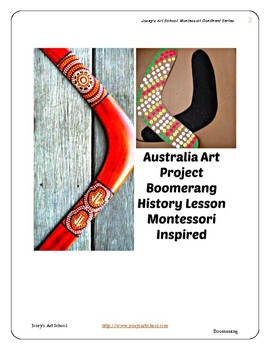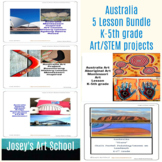Australia Boomerang History Art Lesson Montessori Grade Pre-K to 5th Common Core
- PDF
Also included in
- Attention Montessori and Elementary Teachers! Are you looking for a fun and engaging way to teach your students about Australia? Look no further than our Australia Theme 5 Art STEM Lessons Bundle, which includes easy-to-follow geography projects and stand-alone art lessons.Our bundle includes five uPrice $11.99Original Price $15.95Save $3.96
Description
Welcome to this amazing bundle of art lessons featuring the history and art of the Australia Boomerang! This lesson bundle is perfect for Montessori and elementary teachers who are looking to promote cultural understanding and diversity in their classrooms.
The boomerang has been a part of Australian Aboriginal culture for thousands of years, and this lesson bundle explores the history and significance of this iconic tool. Here are four ways to integrate this lesson bundle into other areas of the curriculum:
- History: Use this lesson bundle as part of a unit on Australian Aboriginal history. Have students learn about the culture, traditions, and beliefs of the Aboriginal people, including their use of the boomerang. Discuss the different types of boomerangs and their uses, and how they were used for hunting, ceremony, and entertainment.
- Geography: Use this lesson bundle to explore the geography and ecology of Australia. Discuss the different regions of Australia and how the Aboriginal people adapted to their environment. Have students create their own boomerangs inspired by the landscape and natural features of Australia.
- Science: Use this lesson bundle to explore the physics and aerodynamics of the boomerang. Discuss the principles of flight and how the shape and design of the boomerang allow it to return to its thrower. Have students experiment with different designs and angles to create their own boomerangs.
- Art: Use this lesson bundle to explore different art styles and techniques. Have students create their own boomerang designs using traditional Aboriginal dot painting techniques. Encourage them to incorporate symbols and patterns that represent different aspects of Aboriginal culture.
In conclusion, this bundle of art lessons featuring the history and art of the Australia Boomerang is a fantastic way to introduce students to a unique and important aspect of Australian Aboriginal culture. By incorporating this lesson bundle into your curriculum, you can promote cultural understanding and diversity while engaging your students in a fun and educational experience. We hope you enjoy this lesson bundle and the opportunity to explore the rich history and art of the Australia Boomerang!
THIS LESSON COMPLIES WITH MANY ELA COMMON CORE STANDARDS
Continent: Australia
Art Project: Boomerang
-Copy of the real life paintings
-Discussion about the topic and real life pictures to engage with the students in deeper conversation
-questions to ask your students to engage the pictures
-FULL COLOR AND THOROUGH step by step instructions written by an AMI Montessori trained Primary teacher.
-opportunity to write about the experience
CLICK HERE to view my freebies
CLICK HERE to view my DRAWING LESSONS
CLICK HERE to view my ART WITH THE MASTERS ART LESSONS
CLICK HERE to view my CONTEMPORARY ART LESSONS
CLICK HERE to view my ART LESSONS THAT COMPLIMENT POPULAR BOOKS
CLICK HERE to view my SELF ESTEEM PROJECTS
CLICK HERE to view my CLASS MURAL IDEAS
CLICK HERE to view my FUN ART FOLK ART LESSONS
CLICK HERE to view my 3 BUNDLED LESSONS
CLICK HERE to view my 5 BUNDLED LESSONS
Make sure to click the GREEN STAR near my store name so that you can stay in touch with my store. I create new lessons every week.






